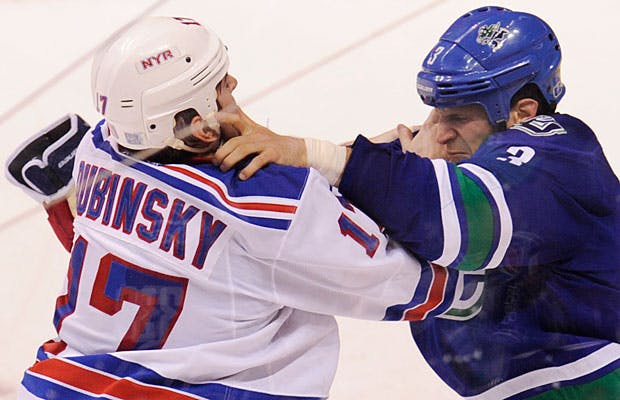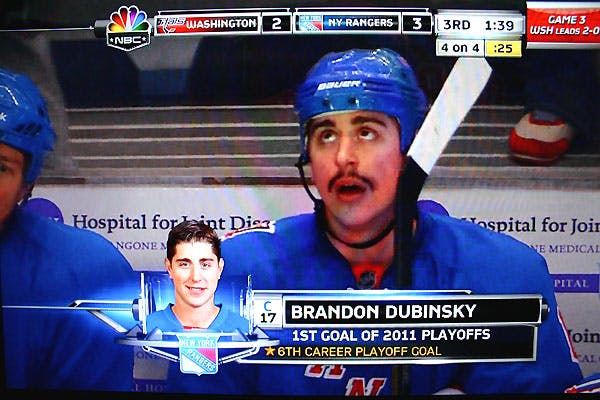Why Brandon Dubinsky Makes Sense in Vancouver
By Jeff Angus
11 years ago
I am not Brandon Dubinsky’s agent. However, I am going to pretend I am for the next 1000 words (give or take). Grantland writer Bill Barnwell recently wrote his NFL free agent previews this way – he would attempt to pitch or ‘sell’ the player to prospective GMs.
Here is an example of one of those columns – offensive tackle Jake Long, who has since signed with the St. Louis Rams.
Dubinsky isn’t the perfect player. He may be overpaid for what he brings to the table offensively. However, I’ll be sticking to a similar formula followed by Mr. Barnwell:
These pieces are designed to be from the perspective of an agent trying to hype up his client as the latter is about to hit free agency. My goal in writing these isn’t to be accurate (or lie), but instead to employ whatever arguments I can to make the player in question look as valuable as possible.
What does Brandon Dubinsky bring to the table?
Let’s do a quick career retrospective. Dubinsky played four years with the Portland Winterhawks (he was a linemate of Jannik Hansen’s in 2005-06). He scored over 20 goals three times, and in his best season (2003-04) he finished with 78 points and 137 PIM in 71 games. The Rangers liked enough of what they saw that season to use the 60th overall pick on him that summer. Don Maloney was running the drafts for the Rangers at the time, and he is now in Phoenix where he serves as GM of the Coyotes. Gee, I wonder if Phoenix could use a player like him? Maloney is well-regarded for identifying talent in places overlooked by other GMs (although to be fair, he did take Al Montoya 6th overall in that same draft year).
Dubinsky had a phenomenal season in the AHL in 2006-07 (his first and only AHL campaign), scoring 21 goals and compiling 115 PIM in 71 games. He played six games in the NHL that year.
He was very solid as a rookie in 2007-08 with the Rangers, finishing with 40 points and 79 PIM in 82 games. He even saw some time on the top line with Jaromir Jagr and Sean Avery. From 2008:
"You start at a certain level and then, as the season goes on, you increase that level because you’re forced to by playing with these guys every day," Dubinsky said. "When you finally get your level up to their level or where it needs to be, then you realize, ‘OK, I do have more time.’ Before, you weren’t at that level, so everything was moving by so quickly that you never felt you had that time."I think that’s a big change for me."
Jagr liked playing with Dubinsky because of how hard he was on the puck (especially along the boards and down low, much like Jagr’s new linemate Jamie Benn). Dubinsky also started to show flashes of a playmaking side.
Mike Gillis took over as Canucks GM in the 2008 offseason, and the club made its first attempt at trading for Dubinsky that summer. They weren’t able to negotiate a trade, and they missed out on David Backes after sending him an offer sheet. 0-for-2 with finding a young power forward that summer.
Dubinsky’s sophomore season was similar to his rookie campaign – 41 points and 112 PIM in 82 games. He scored 20 goals in season three (in only 69 games), too.
But his breakout campaign came in year four (2010-11). Dubinsky scored 24 goals, finished with 54 points, and racked up 100 PIM in 77 games. And his underlying numbers were even more impressive.
Dubinsky played the toughest minutes of any Ranger forward (with a Corsi Relative Quality of Competition rating of 0.977). Essentially, he was out there against strong puck possession players. Corsi Relative isn’t a perfect measure of player quality, but it is much more effective than using any other readily-available metric ("advanced" or otherwise). He still drove the play in the right direction, too (4.7 Corsi Relative rating). And he started less than 50% of his shifts in the offensive zone (47.6% to be exact), too.
A big reason for his offensive jump forward from 2008-09 to 2009-10 and 2010-11? Significant upgrades on his wings.
| 2008-09 | ||
| Frequency | Strength | Line Combination |
| 18.88% | EV | 17 DUBINSKY,BRANDON – 34 VOROS,AARON – 13 ZHERDEV,NIKOLAI |
| 5.27% | EV | 17 DUBINSKY,BRANDON – 29 KORPIKOSKI,LAURI – 13 ZHERDEV,NIKOLAI |
| 4.93% | EV | 23 DRURY,CHRIS – 17 DUBINSKY,BRANDON – 13 ZHERDEV,NIKOLAI |
| 4.44% | EV | 17 DUBINSKY,BRANDON – 91 NASLUND,MARKUS – 13 ZHERDEV,NIKOLAI |
Voros and Zherdev, for the most part.
| 2009-10 | ||
| Frequency | Strength | Line Combination |
| 19.57% | EV | 17 DUBINSKY,BRANDON – 10 GABORIK,MARIAN – 20 PROSPAL,VACLAV |
| 15.38% | EV | 26 CHRISTENSEN,ERIK – 17 DUBINSKY,BRANDON – 10 GABORIK,MARIAN |
| 4.27% | EV | 24 CALLAHAN,RYAN – 23 DRURY,CHRIS – 17 DUBINSKY,BRANDON |
Dubinsky spent a lot of time skating on a line with Gaborik in 2009-10 (his first 20-goal season).
| 2010-11 | ||
| Frequency | Strength | Line Combination |
| 35.12% | EV | 42 ANISIMOV,ARTEM – 24 CALLAHAN,RYAN – 17 DUBINSKY,BRANDON |
| 4.41% | EV | 24 CALLAHAN,RYAN – 17 DUBINSKY,BRANDON – 21 STEPAN,DEREK |
And he finally found regular linemates for his big breakout season in 2010-11. He played primarily left wing on this line, as Anisimov handled the duties of a center.
The Canucks again took a run at Dubinsky during the 2011 offseason, as he and the Rangers were at odds over a new contract (they ended up agreeing on a four-year, $16.8 million pact days before a scheduled arbitration hearing).
And here is a more extensive look at Dubinsky’s advanced numbers from his time with the Rangers:
| Corsi Rel QoC | Corsi Relative | PDO | Pens Taken/60 | Pens Drawn/60 | Off Zone Start % | |
| 2007-08 | 0.06 | 10.7 | 983 | 0.8 | 1.8 | 64.5 |
| 2008-09 | 0.35 | 9 | 989 | 1.1 | 1.3 | 57.3 |
| 2009-10 | 0.98 | 4.7 | 1010 | 0.8 | 1 | 47.6 |
| 2010-11 | 1.44 | 1.9 | 986 | 1 | 1.1 | 48.5 |
| 2011-12 | 0.85 | 8.8 | 1015 | 1.1 | 1.1 | 41.8 |
Dubinsky routinely played against very good players (as evidenced by his positive Corsi Rel QoC). Anything close to or over the 1.0 mark represents very good competition. Dubinsky still found a way to be a positive Corsi Relative player each season, too. He drew more penalties than he took, and as his time in New York progressed, he saw a greater degree of defensive responsibility (as evidenced by Tortorella’s increasing reliance on Dubinsky on defensive zone draws).
Beyond the qualitative stuff, which checks out well, Dubinsky offers a lot. He is versatile, having succeeded in the NHL as both a center and a left winger. He is physical and tough, and he is able to play a variety of roles, depending on what the team asks of him. I am of the mindset that Ryan Kesler’s best long-term fit is on the right wing (he can still take faceoffs, much like Jarome Iginla does in Calgary), but playing on the wing would allow Kesler to shoot the puck as often as he would like. He simply isn’t a natural puck distributor, in my view.
Dubinsky is also relatively young and has many years in front of him. Because of his slightly inflated contract, the Blue Jackets may be open to moving him. And there are a number of teams who could use a solid two-way second liner like him on their respective rosters.
Dubinsky (two more years at $4.2 million per) essentially carries the same cap hit as David Booth (two more years at $4.25 million per). He’s a better fit for Vancouver’s second line than Booth (although ideally they would both be there). If the Canucks can find a way to shed some salary, a Booth-Dubinsky-Kesler could be a dominant puck possession trio (although all three have dealt with injury issues recently, so it may be a stretch to bank on them being healthy at the same time for an extended period of time).
Dubinsky also fits in with Gillis’ MO of getting bigger, stronger, and harder to play against. And he is already on speaking terms with many of his potential teammates:
Previous Posts from Jeff:
- Trade Deadline ’13 – Finding a Center
- The Booth Gamble Not Paying Off
- What is Jordan Schroeder’s Offensive Upside?
I have also been working at developing a free hockey app (Fantasy Hockey PowerPlay) for Android and Apple – similar to RotoWorld, but more in-depth coverage on all breaking news from across the league. Check it out here. We also released a Midseason Guide for free.
Recent articles from Jeff Angus






